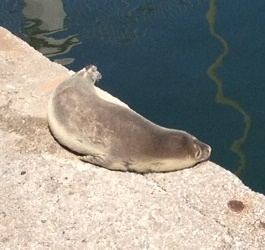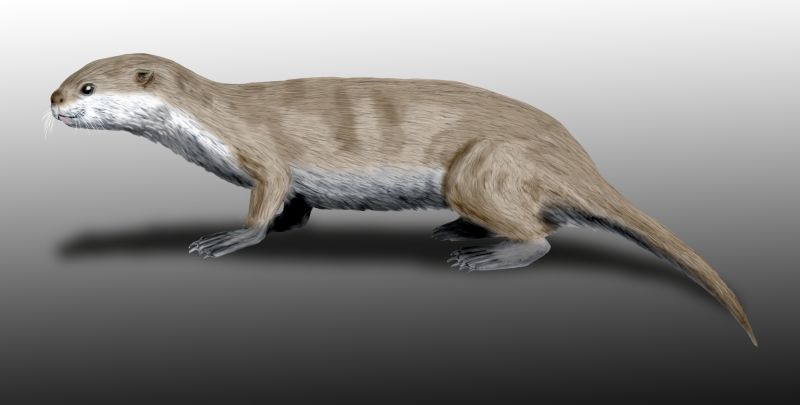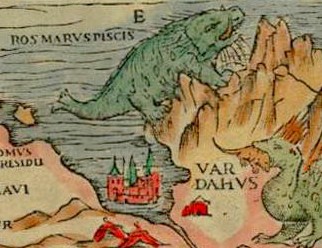|
Phocid
The earless seals, phocids, or true seals are one of the three main groups of mammals within the seal lineage, Pinnipedia. All true seals are members of the family Phocidae (). They are sometimes called crawling seals to distinguish them from the fur seals and sea lions of the family Otariidae. Seals live in the oceans of both hemispheres and, with the exception of the more tropical monk seals, are mostly confined to polar, subpolar, and temperate climates. The Baikal seal is the only species of exclusively freshwater seal. Taxonomy and evolution Evolution The earliest known fossil earless seal is '' Noriphoca gaudini'' from the late Oligocene or earliest Miocene ( Aquitanian) of Italy. Other early fossil phocids date from the mid-Miocene, 15 million years ago in the north Atlantic. Until recently, many researchers believed that phocids evolved separately from otariids and odobenids; and that they evolved from otter-like animals, such as '' Potamotherium'', which inhabit ... [...More Info...] [...Related Items...] OR: [Wikipedia] [Google] [Baidu] |
Pinniped
Pinnipeds (pronounced ), commonly known as seals, are a widely range (biology), distributed and diverse clade of carnivorous, fin-footed, semiaquatic, mostly marine mammals. They comprise the extant taxon, extant families Odobenidae (whose only living member is the walrus), Otariidae (the eared seals: sea lions and fur seals), and Phocidae (the earless seals, or true seals), with 34 extant species and more than 50 extinct species described from fossils. While seals were historically thought to have descended from two ancestral lines, molecular phylogenetics, molecular evidence supports them as a monophyletic group (descended from one ancestor). Pinnipeds belong to the suborder Caniformia of the order Carnivora; their closest living relatives are musteloids (Mustelidae, weasels, Procyonidae, raccoons, skunks and red pandas), having diverged about 50 million years ago. Seals range in size from the and Baikal seal to the and southern elephant seal. Several species exhibit ... [...More Info...] [...Related Items...] OR: [Wikipedia] [Google] [Baidu] |
Otariids
An eared seal, otariid, or otary is any member of the marine mammal family Otariidae, one of three groupings of pinnipeds. They comprise 15 extant taxon, extant species in seven genus, genera (another species became extinct in the 1950s) and are commonly known either as sea lions or fur seals, distinct from true seals (phocids) and the walrus (Odobenidae, odobenids). Otariids are adapted to a semiaquatic lifestyle, feeding and migrating in the water, but breeding and resting on land or ice. They reside in subpolar, temperate, and equatorial waters throughout the Pacific and Southern Oceans, the southern Indian Ocean, Indian, and Atlantic Oceans. They are conspicuously absent in the north Atlantic. The words "otariid" and "otary" come from the Greek language, Greek ' meaning "little ear", referring to the small but visible external ear flaps (Pinna (anatomy), pinnae), which distinguishes them from the Phocidae, phocids. Evolution and taxonomy Morphological and molecular eviden ... [...More Info...] [...Related Items...] OR: [Wikipedia] [Google] [Baidu] |
Eared Seal
An eared seal, otariid, or otary is any member of the marine mammal family Otariidae, one of three groupings of pinnipeds. They comprise 15 extant species in seven genera (another species became extinct in the 1950s) and are commonly known either as sea lions or fur seals, distinct from true seals (phocids) and the walrus ( odobenids). Otariids are adapted to a semiaquatic lifestyle, feeding and migrating in the water, but breeding and resting on land or ice. They reside in subpolar, temperate, and equatorial waters throughout the Pacific and Southern Oceans, the southern Indian, and Atlantic Oceans. They are conspicuously absent in the north Atlantic. The words "otariid" and "otary" come from the Greek ' meaning "little ear", referring to the small but visible external ear flaps ( pinnae), which distinguishes them from the phocids. Evolution and taxonomy Morphological and molecular evidence supports a monophyletic origin of pinnipeds, sharing a common ancestor with M ... [...More Info...] [...Related Items...] OR: [Wikipedia] [Google] [Baidu] |
Walrus
The walrus (''Odobenus rosmarus'') is a large pinniped marine mammal with discontinuous distribution about the North Pole in the Arctic Ocean and subarctic seas of the Northern Hemisphere. It is the only extant species in the family Odobenidae and genus ''Odobenus''. This species is subdivided into two subspecies: the Atlantic walrus (''O. r. rosmarus''), which lives in the Atlantic Ocean, and the Pacific walrus (''O. r. divergens''), which lives in the Pacific Ocean. Adult walrus are characterised by prominent tusks and whiskers, and considerable bulk: adult males in the Pacific can weigh more than and, among pinnipeds, are exceeded in size only by the two species of elephant seals. Walrus live mostly in shallow waters above the continental shelves, spending significant amounts of their lives on the sea ice looking for benthic bivalve molluscs. Walruses are relatively long-lived, social animals, and are considered to be a " keystone species" in the Arctic marine regio ... [...More Info...] [...Related Items...] OR: [Wikipedia] [Google] [Baidu] |
Phocides
''Phocides'' is a genus of butterflies in the skipper family, Hesperiidae, in which it is placed in tribe Phocidini, of which it is the namesake genus. The distribution of the genus is primarily Neotropical, but a few species occur in the Nearctic. Species * ''Phocides batabano'' (Lucas, 1857) ** ''P. batabano okeechobee'' (Worthington, 1881) - Florida ** ''P. batabano batabanoides'' (Holland, 1903) - Bahamas ** ''P. batabano batabano'' (Lucas, 1857) - Cuba, Cayman * ''Phocides belus'' Godman & Salvin, [1893] - Mexico * ''Phocides bicolora'' (Boddaert, 1783) - Hispanola * ''Phocides charon'' (C. & R. Felder, 1859) - Brazil, Paraguay * ''Phocides distans'' (Herrich-Schäffer, 1869) ** ''P. distans distans'' - Venezuela ** ''P. distans licinus'' (Möschler, 1879) - Colombia, Panama ** ''P. distans silva'' Evans, 1952 - Peru * ''Phocides johnsoni'' Bell, 1947 - Colombia * ''Phocides lincea'' (Herrich-Schäffer, 1869) - Brazil * ''Phocides metrodorus'' Bell, 1932 ** ''P. metrod ... [...More Info...] [...Related Items...] OR: [Wikipedia] [Google] [Baidu] |
Noriphoca
''Noriphoca'' is an extinct genus of phocid belonging to the subfamily Monachinae. It is known from the late Oligocene to early Miocene of Italy Italy, officially the Italian Republic, is a country in Southern Europe, Southern and Western Europe, Western Europe. It consists of Italian Peninsula, a peninsula that extends into the Mediterranean Sea, with the Alps on its northern land b .... Species The type species of ''Noriphoca'', ''N. gaudini'', was originally named ''Phoca gaudini'' on the basis of a skull from late Oligocene to earliest Miocene deposits in Chiento, Italy. Later authors referred it to either '' Monotherium'', '' Pristiphoca'', or the physeteroid genus '' Paleophoca''. However, it was later shown that ''P. gaudini'' cannot be referred to ''Monotherium'' as the latter was probably phocine and not monachine, and erected ''Noriphoca'' for the stem-monachine species ''P. gaudini''. References {{Taxonbar, from=Q53014899 Miocene pinnipeds Monotypic pr ... [...More Info...] [...Related Items...] OR: [Wikipedia] [Google] [Baidu] |
Phocinae
Phocinae (known colloquially as "Northern seals") is a subfamily of Phocidae whose distribution is found in the seas surrounding the Holarctic, with the Baikal seal (''Pusa sibirica'') being the world's only freshwater species of pinniped. What distinguishes them from other phocid seals is the presence of well-developed claws on their front and back flippers. The Phocinae is divided into three extant tribes: Erignathini (represented by the sole extant bearded seal ''Erignathus barbatus''), Cystophorini (another extant monotypic tribe represented by hooded seal The hooded seal or bladdernose seal (''Cystophora cristata'') is a large phocid found only in the central and western North Atlantic, ranging from Svalbard in the east to the Gulf of St. Lawrence in the west. The seals are typically silver-grey ... ''Cystophora cristata''), and Phocini (represented by the rest of the other surviving species in the subfamily). Members of both Erignathini and Cystophorini have 34 chromoso ... [...More Info...] [...Related Items...] OR: [Wikipedia] [Google] [Baidu] |
Polar Region
The polar regions, also called the frigid zones or polar zones, of Earth are Earth's polar ice caps, the regions of the planet that surround its geographical poles (the North and South Poles), lying within the polar circles. These high latitudes are dominated by floating sea ice covering much of the Arctic Ocean in the north, and by the Antarctic ice sheet on the continent of Antarctica and the Southern Ocean in the south. Definitions The Arctic has various definitions, including the region north of the Arctic Circle (currently Epoch 2010 at 66°33'44" N), or just the region north of 60° north latitude, or the region from the North Pole south to the timberline. The Antarctic is usually defined simply as south of 60° south latitude, or the continent of Antarctica. The 1959 Antarctic Treaty uses the former definition. The two polar regions are distinguished from the other two climatic and biometric belts of Earth, a tropics belt near the equator, and two middle latitud ... [...More Info...] [...Related Items...] OR: [Wikipedia] [Google] [Baidu] |
Tropical
The tropics are the regions of Earth surrounding the equator, where the sun may shine directly overhead. This contrasts with the temperate or polar regions of Earth, where the Sun can never be directly overhead. This is because of Earth's axial tilt; the width of the tropics (in latitude) is twice the tilt. The tropics are also referred to as the tropical zone and the torrid zone (see geographical zone). Due to the overhead sun, the tropics receive the most solar energy over the course of the year, and consequently have the highest temperatures on the planet. Even when not directly overhead, the sun is still close to overhead throughout the year, therefore the tropics also have the lowest seasonal variation on the planet; "winter" and "summer" lose their temperature contrast. Instead, seasons are more commonly divided by precipitation variations than by temperature variations. The tropics maintain wide diversity of local climates, such as rain forests, monsoons, sa ... [...More Info...] [...Related Items...] OR: [Wikipedia] [Google] [Baidu] |
Monk Seal
Monk seals are earless seals of the tribe Monachini. They are the only earless seals found in tropical climates. The two genera of monk seals, ''Monachus'' and ''Neomonachus'', comprise three species: the Mediterranean monk seal, ''Monachus monachus''; the Hawaiian monk seal, ''Neomonachus schauinslandi''; and the Caribbean monk seal, ''Neomonachus tropicalis'', which became extinct in the 20th century. The two surviving species are now rare and in imminent danger of extinction. All three monk seal species were classified in genus ''Monachus'' until 2014, when the Caribbean and Hawaiian species were placed into a new genus, ''Neomonachus''. Monk seals have a slender body and are agile. They have a broad, flat snout with nostrils on the top. Monk seals are polygynous, and group together in harems. They feed mainly on bony fish and cephalopods, but they are opportunistic. The skin is covered in small hairs, which are generally black in males and brown or dark gray in females. Monk ... [...More Info...] [...Related Items...] OR: [Wikipedia] [Google] [Baidu] |
Freshwater Seal
Freshwater seals are pinnipeds which live in freshwater bodies. The group is paraphyletic in nature, the uniting factor being the environment in which these pinnipeds live. The vast majority of all modern seals live solely in saltwater habitats though this is likely due to the rarity of sufficiently large freshwater bodies rather than the limitation of seal biology. Baikal seals The only exclusively freshwater seal species is the Baikal seal, locally named (). The Baikal seal has inhabited Lake Baikal for roughly two million years, the closest relative to it being the Arctic ringed seal whence it has likely descended. The manner by which the baikal seal reached Lake Baikal is still not fully understood, theories include their entrance into the lake via travel up the Yenisei River or perhaps via large lakes which existed in Siberia during the Pleistocene. Ringed seals While the Baikal Seal may be the only unique species of pinniped to live in a purely freshwater environ ... [...More Info...] [...Related Items...] OR: [Wikipedia] [Google] [Baidu] |
Temperate
In geography, the temperate climates of Earth occur in the middle latitudes (approximately 23.5° to 66.5° N/S of the Equator), which span between the tropics and the polar regions of Earth. These zones generally have wider temperature ranges throughout the year and more distinct seasonal changes compared to tropical climates, where such variations are often small; they usually differ only in the amount of precipitation. In temperate climates, not only do latitude, latitudinal positions influence temperature changes, but various sea currents, prevailing wind direction, continentality (how large a landmass is) and altitude also shape temperate climates. The Köppen climate classification defines a climate as "temperate" C, when the mean temperature is above but below in the coldest month to account for the persistence of frost. However, some adaptations of Köppen set the minimum at . Continental climate, Continental climates are classified as D and considered to be varie ... [...More Info...] [...Related Items...] OR: [Wikipedia] [Google] [Baidu] |







